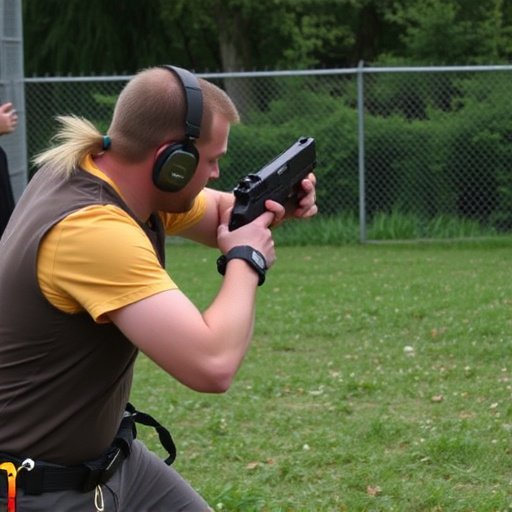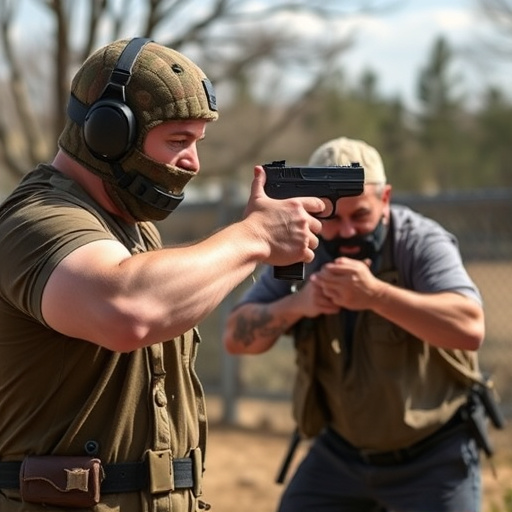Taser Paralysis Duration: Exploring Compact Stun Guns’ Impact
Compact stun guns with integrated chargers, like Tasers, are globally adopted law enforcement tools…….
Compact stun guns with integrated chargers, like Tasers, are globally adopted law enforcement tools that temporarily paralyze subjects with electrical pulses. These devices offer superior convenience and ease of use, with models delivering higher voltage and shorter pulse durations. Paralysis duration varies based on factors including model, voltage, and shock duration, typically ranging from a few minutes to several hours. While they enhance personal security, prolonged or repeated use carries risks, especially for those with pre-existing health issues. Legal variations across jurisdictions exist, with cases revealing inconsistent outcomes, underscoring the need for extensive officer training, strict protocols, and oversight to balance public safety with legal accountability.
“Uncovering the complexities of paralysis durations following Taser deployment, this comprehensive article delves into the immediate effects and long-term implications. With a focus on the rising popularity of compact stun guns equipped with built-in chargers, we explore how design innovations impact stun duration and user safety.
We analyze various factors influencing paralysis, offer medical insights, and examine legal case studies related to Taser use. By understanding these aspects, we aim to shed light on responsible deployment practices for these powerful devices.”
- Understanding Taser Deployment and Its Immediate Effects
- The Impact of Compact Stun Guns with Built-In Chargers
- Factors Influencing Paralysis Duration
- Medical Perspective on Post-Taser Paralysis
- Legal Implications and Case Studies Related to Taser Use
Understanding Taser Deployment and Its Immediate Effects

Taser deployment is a powerful and potentially life-saving tool used by law enforcement agencies worldwide. When activated, these compact stun guns with built-in chargers fire electrical pulses that disrupt muscles, causing temporary paralysis. The immediate effects can last for several seconds to a few minutes, depending on the model of the Taser, the number of darts deployed, and individual factors like body weight and muscle mass.
Understanding the duration and intensity of these effects is crucial. While Tasers are designed to immobilize individuals temporarily, prolonged or repeated deployment could lead to adverse health outcomes. Therefore, officers undergo rigorous training to ensure they use this force-inhibiting technology responsibly and only when necessary, aiming to minimize the impact on those involved.
The Impact of Compact Stun Guns with Built-In Chargers

Compact stun guns with built-in chargers are gaining popularity due to their convenience and ease of use. These devices offer a quick, effective way to deter potential threats, providing users with a sense of security. The integrated charger eliminates the need for separate charging equipment, making it a practical choice for individuals seeking personal protection. This compact design allows for easy carrying, ensuring that the stun gun is readily available when needed.
The impact of these devices extends beyond their portability. Built-in chargers enable users to stay prepared without constantly worrying about battery life or charging accessibility. This feature is particularly valuable in situations where quick deployment is crucial, such as self-defense or law enforcement scenarios. With a simple activation mechanism, individuals can utilize the stun gun’s high voltage output, temporarily paralyzing the target for escape or further intervention.
Factors Influencing Paralysis Duration

The duration of paralysis caused by a taser deployment can vary significantly based on several factors. One key consideration is the model of the stun device; modern compact stun guns with built-in chargers often deliver higher voltage and shorter pulse durations, potentially reducing the time an individual remains paralyzed. The strength and proximity of the shock play a crucial role too; direct contact at close range tends to induce quicker paralysis compared to indirect or distant applications.
Additionally, factors like the user’s body type, physical fitness, and muscle tone can influence how long they remain immobile after a taser strike. Individuals with higher muscle mass might experience longer-lasting paralysis due to the higher electrical load their bodies absorb. Environmental conditions, such as temperature and humidity, could also subtly impact the intensity and duration of the stun, though these effects are often less significant than the device’s design and user’s physical characteristics.
Medical Perspective on Post-Taser Paralysis

From a medical perspective, the duration of paralysis following the deployment of a taser can vary significantly. The impact depends on several factors, including the specific model of the compact stun gun with built-in charger, the voltage output, and the duration of the shock. Typically, symptoms can last from a few minutes to as long as several hours. During this time, individuals may experience muscle weakness or complete paralysis in the affected areas.
Medical professionals emphasize that while tasers are designed for self-defense and law enforcement purposes, their use does carry risks. Prolonged or repeated exposure to electrical shocks from a taser can lead to more severe and prolonged paralysis, especially in individuals with pre-existing health conditions. It’s crucial for users to be aware of these potential side effects and seek immediate medical attention if symptoms persist or worsen after a taser deployment.
Legal Implications and Case Studies Related to Taser Use

The legal implications surrounding the use of compact stun guns with built-in chargers, such as Tasers, vary significantly across jurisdictions. In many regions, law enforcement agencies are permitted to employ these devices as non-lethal force options during high-risk situations. However, the duration and consequences of paralysis induced by Taser deployment remain contentious in legal arenas. Case studies have highlighted varying outcomes, from temporary immobilization to severe and prolonged muscle spasms, which can lead to significant legal repercussions for law enforcement officers if misuse is suspected.
Several notable cases have shed light on the potential for excessive force when Tasers are used. In some instances, individuals have suffered lasting physical injuries or even died after Taser deployment, leading to civil lawsuits and criminal investigations. These incidents underscore the importance of proper training, protocol adherence, and ongoing monitoring to ensure that stun guns are utilized only as a last resort and in accordance with established guidelines. Law enforcement agencies must carefully navigate the balance between public safety and the potential for legal repercussions when integrating compact stun guns into their tactics.
The duration of paralysis following taser deployment is a complex topic influenced by various factors, including the design of the weapon and individual physiological differences. Compact stun guns with built-in chargers have gained attention for their convenience and potential to reduce deployment time. However, studies show that the immediate effects of a taser can last for several minutes, during which proper medical attention is crucial. Understanding the legal implications and continuing research into post-taser paralysis are essential steps towards ensuring safe and effective use of these devices. By examining these factors, we can navigate the balance between public safety and mitigating the risks associated with taser deployment.


